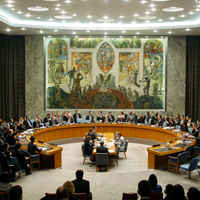For the past eight months, Western nations at the United Nations Security Council have unsuccessfully sought to impose sanctions on the government of Syrian President Bashar al-Assad for its violent repression of a pro-reform revolt across the country. The effort follows their success last February in getting the council to impose muscular penalties on the now-defunct government of former Libyan leader Moammar Gadhafi. Meanwhile, U.N. sanctions are currently in place against North Korea and Iran as a response to these countries' violations of international nonproliferation obligations. Despite the diverging motivations behind each of these efforts to penalize the targeted countries, they are all the result of an elemental reform in the application of national and global economic statecraft to constrain and influence the actions of rogue regimes and, increasingly, nonstate actors.
Though these new tools are prominent and the changes appreciable, in the public discourse coercive economic statecraft is still synonymous with trade embargos. It is true that trade boycotts were once the preferred instrument of economic power, but for the past two decades the international community has shown a clear predilection for a more refined subset of coercive tools, including targeted financial sanctions.
Sanctions Old and New

